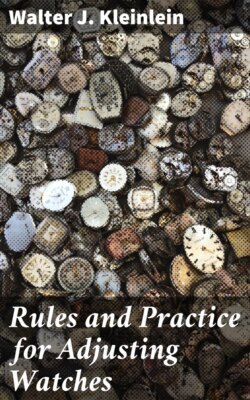Читать книгу Rules and Practice for Adjusting Watches - Walter J. Kleinlein - Страница 9
На сайте Литреса книга снята с продажи.
1. General Method of Obtaining Results.
ОглавлениеOnly since the introduction of the compensation balance which received its most substantial early experiments as recently as the year 1859, has it been possible to control the variation in pocket timepieces which is caused by changes in temperature. Previous to this introduction it was not uncommon for the best watches to vary as much as two or three minutes with changes of forty or fifty degrees Fahr. Through experiment and improvement in the quality and application of balance materials, such advancement has been made, that this variation has been reduced to seconds and temperature adjusting is now quite universal in the production of medium and high grade watches.
In the large factories, girls and young men of very little previous experience are frequently taught to make the alterations and to do the testing, while men of experience in watchmaking handle only the more intricate cases such as "stoppers" and radical rates that may require investigation of the inner workings of the movement. The simplicity of the adjustment naturally becomes more apparent with experience and the general alterations consist merely of transferring the balance screws in opposite pairs, either forward or backward one or more holes, according to the extent of the correction desired.
As these alterations are quite positive the adjustment can be undertaken with considerable certainty of obtaining results in every instance.
The repairer will not find as much daily necessity for understanding temperature adjusting as he will for being thorough in Position adjusting. The subject is covered, however, for the benefit of those who may desire practical experience in this branch of adjusting and also for those who desire a general knowledge of the details.
